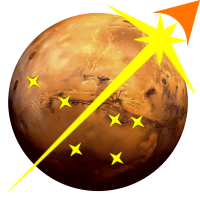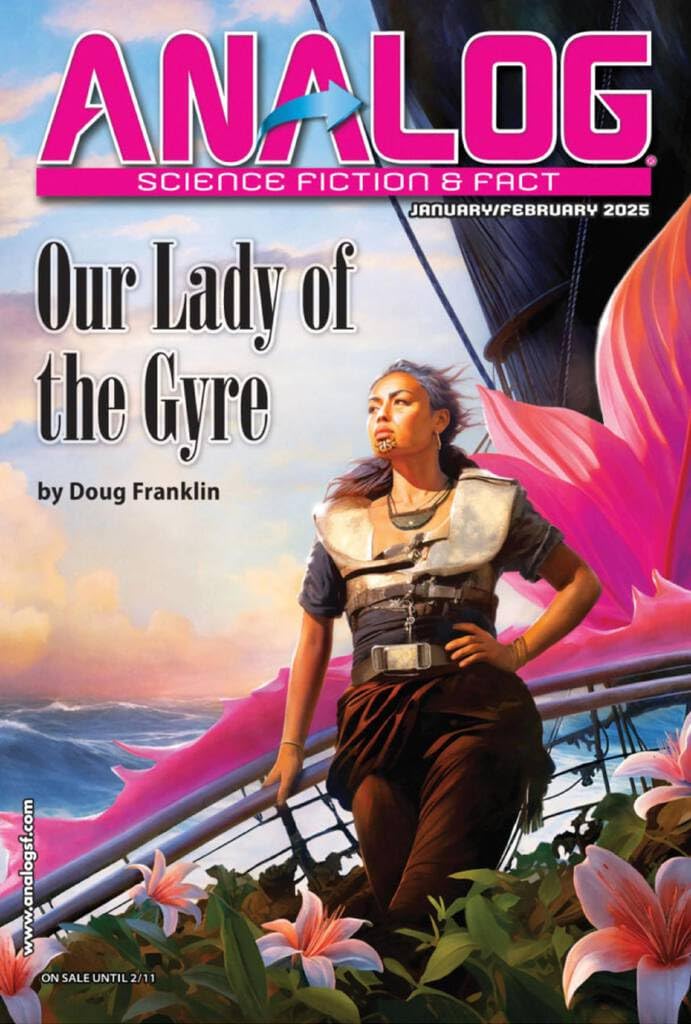
I’m happy to report another sale to ANALOG SCIENCE FICTION AND FACT. No spoilers here, of course, but my novelette “The Origami Man” is a mashup of three core concepts:
All wrapped in a delicious near-future setting in the Gulf of Alaska, where the Anthropocene has come to roost.
No idea when it will be published – hopefully sometime in 2025! More to come…

And it’s in the wild! Available now via Amazon Kindle or your Analog subscription, and it should be on the shelves of your local bookstore tomorrow 12/10/2024. W00t!

When writing “Gray Lies,” I was thinking about how a transformative technology like World War 2’s surface ships versus aircraft could come about in the context of interplanetary warfare. Thanks to Larry Niven I was obsessed with Bussard ramjets and I settled on the scenario of old-guard fusion torchships – fusion rockets – being trounced by interplanetary ramjets. (This was before critics calculated that a ramjet would produce more drag than thrust.) I was also thinking a lot about Von Neumann probes – self-replicating space probes that could sweep through the galaxy in fairly short timeframes as these things go. Oh, and the idea of being able to upload minds into computers. It was a lot to pack into one short story.
I wrote it while obsessively listening to the 1990 release of Best of Van Morrison. Which is odd for several reasons; I’m more of a Pink Floyd / Grateful Dead kind of guy, and I usually don’t listen to anything with words while writing. Regardless, Best of Van Morrison was what got me into the groove, and is probably why the story has such an optimistic, or at least kind, ending.
The universe the original story imagines is immediately adjacent to that of THE EXTRAPOLATED MAN. I always enjoyed the works of authors who had created a somewhat consistent but large universe – again, Larry Niven in his Known Space universe, and much earlier, Robert Heinlein. Though it was sometimes hard to see how the pieces all fit together in Heinlein’s case! In any case, it would not take much of a rewrite to nudge “Gray Lies” over. The main discrepancy is the war between Pallas and Confive; in THE EXTRAPOLATED MAN, the main conflict is between Earth (or proxies thereof) and Mars. And I’ve largely moved on from ramjets to more esoteric drive technologies, so that might have to be adjusted. But these are minor fixes – surface details that are easily reworked.
So enjoy the original here; odds are good by the time it gets to Amazon it’ll be polished up to present the illusion that I’ve known what I was doing from the beginning!
– Magazine cover art by Peter Peebles
“The Transformative Ethic” was the first short story I sold, and I am forever indebted to Charles Ryan for taking me on, and to David Cherry for his amazing artwork – both the cover and the interior! Aboriginal Science Fiction was a class act.
I finished “The Transformative Ethic” way back in 1990, while I was working – and living, four weeks out of six – at Cominco Red Dog Mine. Red Dog is the world’s largest zinc producer, and it’s located above the Arctic Circle. That far north, the sun sets for a month in mid-winter. The mine site is a self-contained village, with pre-fab living quarters and office buildings built on stilts to keep from melting the permafrost and diesel generators running twenty-four hours a day. It’s a bit like living on the moon, or an asteroid perhaps. Think Outland without the gun fights and sex-appeal of Sean Connery.
An amusing factoid about the office buildings is that they were constructed in the Philippines, and as a result had two undesirable features: a small population of large tropical insects, and a complete lack of air-conditioning. Because if you live in the Philippines, you’d think it’s always cold above the Arctic Circle, right? Makes sense. But in high summer the sun never sets, and it actually gets quite warm. And there are many, many, many mosquitoes who find the CO2 wafting out of open doors and windows just so deliciously appealing. As one of two on-site IT guys, I had the relative luxury of being able to retreat to the server room, just about the only cool indoors place to work in the summer.
Red Dog is the polar opposite (sorry, couldn’t resist) of the research bases down in Antarctica, dedicated to ripping one of the building blocks of civilization-as-we-know-it out of the Earth instead of improving our understanding of it. I cannot even imagine what its carbon footprint must be, not that we were thinking much about that in 1990. An uncomfortable tension of living in Alaska, one of the most beautiful places on the planet, is that it’s all paid for by the ugly business of resource extraction. “If you can’t grow it, you have to mine it,” the saying goes. Or pump it.
But one thing I learned about open-pit mines from direct experience – and subsequent monitoring of various catastrophic events around the world – is that they are intrinsically dirty operations that are inimical to the natural environmental. We tried hard to be good, really. I’d say Red Dog is (or at least was – no clue about current management) an ethical operator that tried to do the right thing. But here’s the deal: when you rip the “overburden” off the top of an ore deposit with ginormous machines, you expose everything underneath to the elements. There used to be a big old hill covered with tundra. Now there’s a big old pit instead, and that pit absorbs snow and rain, and that water has to go somewhere. It used to mostly just roll off into the nearest stream. Now… it seeps through a bunch of toxic metals into the nearest stream. And kills it. And kills the next, bigger creek downstream. And so on.
And then there there is the tailings pond, where all the sludge from the extraction process goes. As far as I know, Red Dog’s tailings pond dam has held up, but many others have not. And when they go, it’s a real disaster both for the environment and for any communities that are in the way, or rely on that environment for “services” like water. Or food. This is especially a problem for mines that become insolvent, which means the operator can’t pay for maintenance, much less remediation.
So my main takeaway from all this is that yeah, mining is 100% critical to civilization-as-we-know-it, and it is also a dirty business that is, in the long run, extraordinarily destructive of the natural environment. Which – make no mistake! – we depend upon to survive. That’s why people in Alaska are so adamantly opposed to Pebble Mine, which would wipe out an entire fishery if (or more likely when) it has a problem. Not to mention that all the profits from Pebble would go out of country to fat cats in Canada. I mean… it’s really a lose-lose-lose proposition for the folks who live here.
But I digress. Here’s my optimistic sci-fi author perspective: yeah, in the short term we need to mine it, and pump it. And that sucks. So let’s account for the actual full life-cycle cost (instead of unloading that onto future generations), and use that cost to drive toxic operations off-planet (I’m looking at you Psyche!) and build the infrastructure to meet our needs with non-toxic alternatives.
/rant